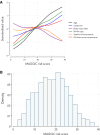Meta-Analysis Global Group in Chronic (MAGGIC) Heart Failure Risk Score: Validation of a Simple Tool for the Prediction of Morbidity and Mortality in Heart Failure With Preserved Ejection Fraction
- PMID: 30371285
- PMCID: PMC6474968
- DOI: 10.1161/JAHA.118.009594
Meta-Analysis Global Group in Chronic (MAGGIC) Heart Failure Risk Score: Validation of a Simple Tool for the Prediction of Morbidity and Mortality in Heart Failure With Preserved Ejection Fraction
Abstract
Background The Meta-Analysis Global Group in Chronic Heart Failure ( MAGGIC ) mortality risk score, derived from a large sample of patients with heart failure ( HF ) across the spectrum of ejection fraction ( EF ), has not yet been externally validated in a well-characterized HF with preserved EF cohort with adjudicated morbidity outcomes. Methods and Results We evaluated the MAGGIC risk score (composed of 13 clinical variables) in 407 patients with HF with preserved EF enrolled in a prospective registry and used Cox regression to evaluate its association with morbidity/mortality. We used receiver-operating characteristic analysis to compare the predictive ability of the MAGGIC risk score with the more complex Seattle Heart Failure Model, and we determined the value of adding B-type natriuretic peptide to the MAGGIC risk score for risk prediction. During a mean follow-up time of 3.6±1.8 years, 28% died, 32% were hospitalized for HF , and 55% had a cardiovascular hospitalization and/or death. The MAGGIC score, a mean± SD of 18±7, was significantly associated with mortality ( P<0.0001), HF hospitalizations ( P<0.0001), and the combined end point of cardiovascular-related hospitalizations or death (hazard ratio, 1.8 [95% confidence interval, 1.6-2.1], per 1- SD increase in the MAGGIC score; P<0.0001). Receiver-operating characteristic analyses showed that MAGGIC and Seattle Heart Failure Model performed similarly in predicting HF with preserved EF outcomes, but the MAGGIC score demonstrated better calibration for hospitalization outcomes. Further analyses showed that B-type natriuretic peptide was additive to the MAGGIC risk score for predicting outcomes ( P<0.01 by likelihood ratio test). Conclusions The MAGGIC risk score is a simple, yet powerful method of risk stratification for both morbidity and mortality in HF with preserved EF . Clinical Trial Registration URL: http://www.clinicaltrials.gov . Unique identifier: NCT01030991.
Keywords: heart failure; morbidity; mortality; risk assessment.
Figures






Similar articles
-
Validation of the MAGGIC (Meta-Analysis Global Group in Chronic Heart Failure) heart failure risk score and the effect of adding natriuretic peptide for predicting mortality after discharge in hospitalized patients with heart failure.PLoS One. 2018 Nov 28;13(11):e0206380. doi: 10.1371/journal.pone.0206380. eCollection 2018. PLoS One. 2018. PMID: 30485284 Free PMC article.
-
Prognostic value of growth differentiation factor-15 in heart failure among whole ejection fraction phenotypes.ESC Heart Fail. 2024 Aug;11(4):2295-2304. doi: 10.1002/ehf2.14807. Epub 2024 Apr 19. ESC Heart Fail. 2024. PMID: 38641904 Free PMC article.
-
Prognostic value of baseline plasma amino-terminal pro-brain natriuretic peptide and its interactions with irbesartan treatment effects in patients with heart failure and preserved ejection fraction: findings from the I-PRESERVE trial.Circ Heart Fail. 2011 Sep;4(5):569-77. doi: 10.1161/CIRCHEARTFAILURE.111.962654. Epub 2011 Jun 29. Circ Heart Fail. 2011. PMID: 21715583 Clinical Trial.
-
Differing prognostic value of pulse pressure in patients with heart failure with reduced or preserved ejection fraction: results from the MAGGIC individual patient meta-analysis.Eur Heart J. 2015 May 7;36(18):1106-14. doi: 10.1093/eurheartj/ehu490. Epub 2015 Jan 23. Eur Heart J. 2015. PMID: 25616644 Review.
-
Systematic review and meta-analysis to predict mortality in heart failure with preserved ejection fraction: Development and validation of the HF-DANAS score.ESC Heart Fail. 2024 Dec;11(6):4104-4115. doi: 10.1002/ehf2.15008. Epub 2024 Aug 8. ESC Heart Fail. 2024. PMID: 39118428 Free PMC article.
Cited by
-
Clinical Predictive Modeling of Heart Failure: Domain Description, Models' Characteristics and Literature Review.Diagnostics (Basel). 2024 Feb 17;14(4):443. doi: 10.3390/diagnostics14040443. Diagnostics (Basel). 2024. PMID: 38396482 Free PMC article. Review.
-
Biomarker-driven prognostic models in chronic heart failure with preserved ejection fraction: the EMPEROR-Preserved trial.Eur J Heart Fail. 2022 Oct;24(10):1869-1878. doi: 10.1002/ejhf.2607. Epub 2022 Jul 24. Eur J Heart Fail. 2022. PMID: 35796209 Free PMC article.
-
Evaluating risk prediction models for adults with heart failure: A systematic literature review.PLoS One. 2020 Jan 15;15(1):e0224135. doi: 10.1371/journal.pone.0224135. eCollection 2020. PLoS One. 2020. PMID: 31940350 Free PMC article.
-
Performance of risk models to predict mortality risk for patients with heart failure: evaluation in an integrated health system.Clin Res Cardiol. 2024 Sep;113(9):1343-1354. doi: 10.1007/s00392-024-02433-2. Epub 2024 Apr 2. Clin Res Cardiol. 2024. PMID: 38565710
-
Prediction of recurrent heart failure hospitalizations and mortality using the echocardiographic Killip score.Clin Res Cardiol. 2025 May;114(5):609-615. doi: 10.1007/s00392-024-02473-8. Epub 2024 Jun 3. Clin Res Cardiol. 2025. PMID: 38829411 Free PMC article.
References
-
- Shah SJ, Heitner JF, Sweitzer NK, Anand IS, Kim HY, Harty B, Boineau R, Clausell N, Desai AS, Diaz R, Fleg JL, Gordeev I, Lewis EF, Markov V, O'Meara E, Kabulia B, Shaburishvili T, Solomon SD, Pitt B, Pfeffer MA, Li R. Baseline characteristics of patients in the treatment of preserved cardiac function heart failure with an aldosterone antagonist (TOPCAT) trial. Circ Heart Fail. 2013;6:184–192. - PMC - PubMed
-
- Steinberg BA, Zhao X, Heidenreich PA, Peterson ED, Bhatt DL, Cannon CP, Hernandez AF, Fonarow GC; Get With the Guidelines Scientific Advisory Committee and Investigators . Trends in patients hospitalized with heart failure and preserved left ventricular ejection fraction: prevalence, therapies, and outcomes. Circulation. 2012;126:65–75. - PubMed
Publication types
MeSH terms
Substances
Associated data
LinkOut - more resources
Full Text Sources
Medical
Research Materials
Miscellaneous

